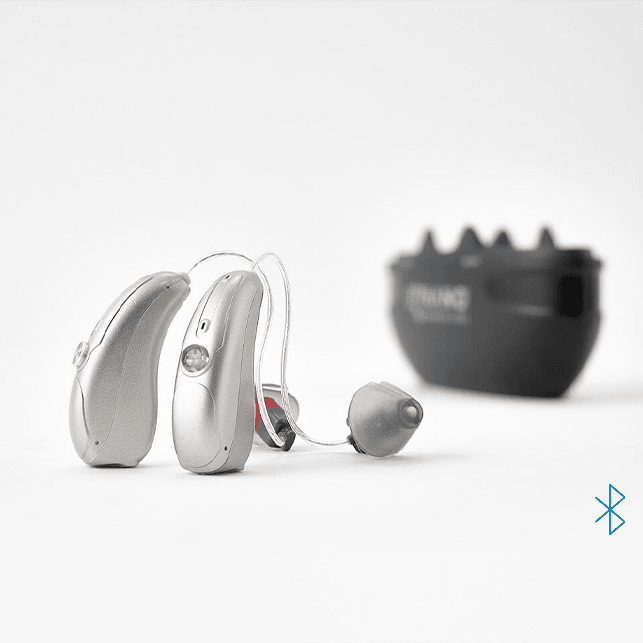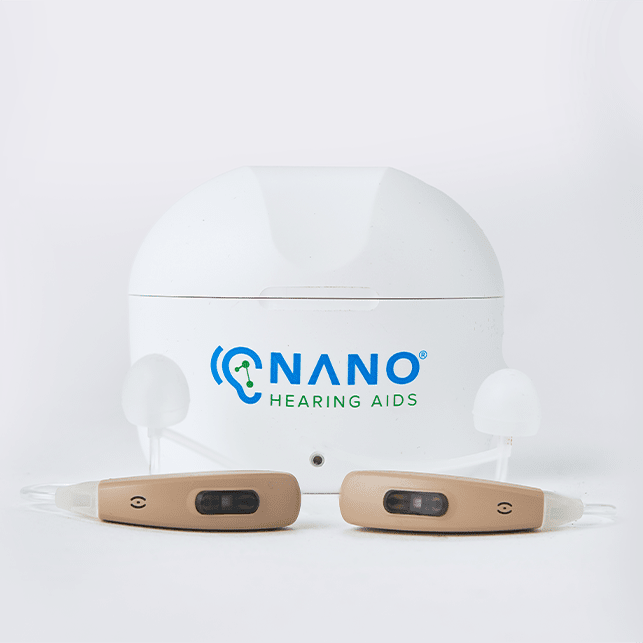Key Takeaways
What is Cookie-Bite Hearing Loss?
A study published in the Journal of Laryngology and Otology says that cookie-bite hearing loss is a type of sensorineural hearing loss, which occurs due to impairment in the auditory nerves. This hearing loss develops slowly, is permanent, and is more challenging to detect than other hearing loss types.
The term "cookie-bite" comes from the U-shaped pattern seen on an audiogram result for people with mid-range or mid-frequency hearing loss. This pattern looks like someone took a bite out of a cookie, which is how it got its name.
Humans can typically hear sounds from the range of 20 to 20,000 Hz.
People with cookie-bite hearing loss struggle to hear mid-frequency sounds, typically between 500 Hz and 2000 Hz, a range of sounds that are crucial for understanding speech and music. As a result, people may hear background noises like a slamming door but miss someone speaking nearby.

If the problem is not congenital, this condition develops gradually, starting in a person's 20s and worsening into their 30s or 40s. Because many sounds are still audible, it often goes unnoticed until it becomes severe, leading to delays in diagnosis and treatment.
Nano Hearing Aids are FDA-registered, Class I devices. These OTC hearing aids are designed for individuals over 18 years of age with perceived mild to moderate hearing impairment. Nano won the Top ENT Solution Provider 2023, has 24/7 customer care, and has an affordable price compared to others.
Reasons Behind Cookie-Bite Hearing Loss
Cookie-bite hearing loss often runs in families. Genetic mutations, particularly in genes such as TECTA, COL11A2, and CCDC50, can lead to this condition.
Acoustic neuroma is a rare and benign tumor that develops on the vestibulocochlear nerve, which is responsible for hearing and balance. This tumor can disrupt auditory signals and result in mid-frequency hearing loss characteristic of the cookie bite pattern.
Exposure to loud noises over time can contribute to sensorineural hearing loss, including cookie-bite patterns. Certain ototoxic medications, like some antibiotics and chemotherapy drugs, may damage the auditory system and cause this issue.
Cookie-Bite Hearing Loss Symptoms
When someone suffers from cookie-bite hearing loss, they find it challenging to hold a conversation properly and may also face problems during presentations, meetings, and interviews. As a result, their social and professional life gets highly hampered.
People with mid-frequency hearing loss might also miss warning messages in public places. They can feel distressed whenever they hear sirens or alarms. As they don’t get to hear sounds clearly, they need to raise the TV volume to understand what they are watching. It becomes tough to listen to music and to interpret environmental sounds as they occur.
How Can Cookie-Bite Hearing Loss Be Diagnosed?
Diagnosing cookie-bite hearing loss involves taking an audiogram - a hearing test that displays results on a graph. The graph shows the softest sounds you can hear and highlights specific patterns, like the "cookie-bite" shape, that indicate mid-range hearing loss.
If the condition runs in the family, it’s often discovered during a child’s early hearing tests. However, if it develops over time, it may go unnoticed until it worsens, as it often starts with mild symptoms. If you have this type of hearing loss, others might notice your hearing issues before you do. Once diagnosed, it’s important to begin treatment quickly to prevent further complications.
Cookie-Bite Hearing Loss Treatments
Cookie-bite hearing loss is permanent and cannot be cured with surgery or medication. However, treatment options can help you manage it, improve your hearing, and protect your hearing health from worsening. Here are the available treatment options:
Hearing Aids for Cookie-Bite Hearing Loss
Hearing aids are the best solution for permanent hearing loss, including cookie-bite hearing loss. These devices amplify mid-frequency sounds, helping users hear and communicate more confidently. Trusted brands like Oticon, Phonak, Nano Hearing Aids, and Widex offer reliable options to choose from.

Making Adaptations
How Can Nano Hearing Aids Help?
Hearing aids are the best solution for sensorineural hearing loss, including cookie-bite hearing loss. This type of hearing loss affects mid-frequency sounds, so you'll need hearing aids that can amplify and adjust those frequencies. This will help you understand speech and interact in social or noisy environments.
At Nano Hearing Aids, we've got some great options - like the Audacity RIC, First Ear Plus CIC, and First Ear Plus BTE. Our devices are FDA-registered, rechargeable, and feature powerful feedback management and noise reduction technology for good sound clarity. You’ll even get a 45-day money back guarantee to ensure that you’re getting the highest quality hearing aid.
Final Words
It can be tricky to detect cookie-bite hearing loss since it develops slowly over time. If you're having trouble hearing speeches, conversations, music, or TV, it's a good idea to get an audiogram to check for this issue. If anyone in your family already has it, you should definitely get checked out to see if you have it too, since it's often genetic.
If you're diagnosed with cookie-bite hearing loss, make sure you take the necessary steps right away, since it can get worse over time. Hearing aids are the best thing you can do to help with this problem, and with the right device, you'll be able to hear mid-frequency sounds again and get back to your everyday life.
Frequently Asked Questions (FAQ)
Yes, cookie-bite loss hearing loss is progressive. It can worsen over time, so make sure to not make any delay in starting treatment after you get diagnosed with it.
Yes, hearing aids can help with cookie-bite hearing loss. You need a hearing aid that is good at amplifying mid-range sounds.
Yes, Nano Hearing Aids can help with minimizing symptoms of cookie-bite hearing loss, especially for adults with perceived mild to moderate hearing loss.


